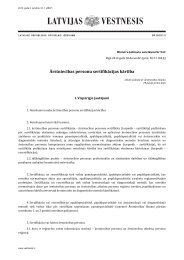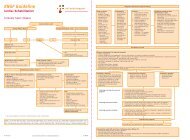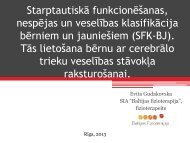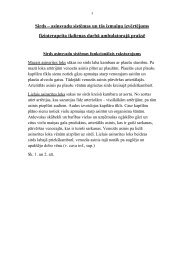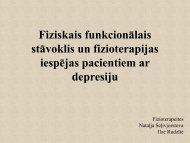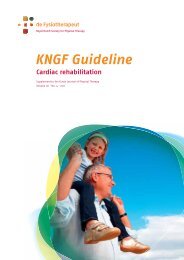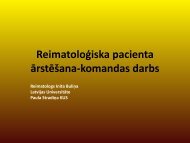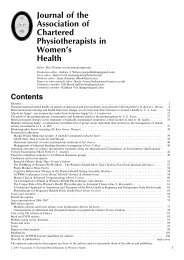Create successful ePaper yourself
Turn your PDF publications into a flip-book with our unique Google optimized e-Paper software.
• Spinal biomechanics<br />
• Sports physical therapy residency education<br />
• Sports rehabilitation<br />
<strong>Low</strong> <strong>Back</strong> <strong>Pain</strong>: Clinical Practice Guidelines<br />
Comments from these reviewers were utilized by the authors<br />
to edit these clinical practice guidelines prior to submitting<br />
them for publication to the Journal of Orthopaedic & Sports<br />
Physical Therapy. In addition, several physical therapists<br />
practicing in orthopaedic and sports physical therapy settings<br />
were sent initial drafts of this clinical practice guideline<br />
along with feedback forms to assess its usefulness, validity,<br />
and impact.<br />
Several practicing clinicians and reviewers noted that the<br />
classification criteria summary of the ICF-based Neck <strong>Pain</strong><br />
Clinical Practice Guidelines 49 was useful in linking data gathered<br />
during the patient’s subjective and physical examinations<br />
to diagnostic classification and intervention. Thus, similar<br />
recommended classification criteria were included by the<br />
authors for these ICF-based <strong>Low</strong> <strong>Back</strong> <strong>Pain</strong> Clinical Practice<br />
Guidelines, which provide a summary of symptoms, impairment<br />
findings, and matched interventions for each diagnostic<br />
category. This summary is provided in the Recommended<br />
<strong>Low</strong> <strong>Back</strong> <strong>Pain</strong> Impairment/Function-based Classification<br />
Criteria with Recommended Interventions table.<br />
CLASSIFICATION<br />
The primary ICD-10 codes and conditions associated with<br />
low back pain are: M99.0 Lumbosacral segmental/somatic dysfunction,<br />
M53.2 Spinal instabilities, M40.3 Flatback syndrome,<br />
M51.2 Lumbago due to displacement of intervertebral disc, M54.1<br />
Lumbar radiculopathy, M54.4 Lumbago with sciatica, M54.5 <strong>Low</strong><br />
back pain, G96.8 Disorder of central nervous system, specified as<br />
central nervous system sensitivity to pain, and F45.4 Persistent somatoform<br />
pain disorder. 324 The corresponding ICD-9-CM codes<br />
and conditions, which are used in the United States, are 739.3<br />
Nonallopathic lesion, lumbar region, 846.0 Lumbosacral ligament<br />
sprain, 724.3 Sciatica, 724.4 Thoracic or lumbosacral neuritis or radiculitis,<br />
unspecified, and 724.2 Lumbago.<br />
Methods (continued)<br />
a6 | april 2012 | volume 42 | number 4 | journal of orthopaedic & sports physical therapy<br />
The primary ICF body-function codes associated with the<br />
above noted ICD-10 conditions are b28013 <strong>Pain</strong> in back,<br />
b28018 <strong>Pain</strong> in body part, specified as pain in buttock, groin, and<br />
thigh, b28015 <strong>Pain</strong> in lower limb, b2803 Radiating pain in a dermatome,<br />
b2703 Sensitivity to a noxious stimulus, b2800 Generalized<br />
pain, b7101 Mobility of several joints, b7108 Mobility of joint<br />
functions, specified as mobility in a vertebral segment, b7601<br />
Control of complex voluntary movements, b789 Movement functions,<br />
specified as mobility of the meninges, peripheral nerves and<br />
adjacent tissues, b1520 Appropriateness of emotion, b1522 Range<br />
of emotion, b1528 Emotional functions, specified as the tendency<br />
to elaborate physical symptoms for emotional/affective reasons,<br />
b1602 Content of thought, and b1608 Thought functions, specified<br />
as the tendency to elaborate physical symptoms for cognitive/<br />
ideational reasons.<br />
The primary ICF body-structure codes associated with low<br />
back pain are s76001 Thoracic vertebral column, s76002 Lumbar<br />
vertebral column, s7602 Ligaments and fasciae of trunk, s130 Structure<br />
of meninges, s1201 Spinal nerves, s7601 Muscles of trunk, s7401<br />
Joints of pelvic region, s7402 Muscles of pelvic region, s75001 Hip<br />
joint, s75002 Muscles of thigh, s1100 Structure of cortical lobes,<br />
s1101 Structure of midbrain, s1102 Structure of diencephalon, s1103<br />
Basal ganglia and related structures, s1104 Structure of brainstem,<br />
and s1200 Structure of spinal cord.<br />
The primary ICF activities and participation codes associated<br />
with low back pain are d4108 Bending, d4106 Shifting the<br />
body’s centre of gravity, d4158 Maintaining a body position, d4153<br />
Maintaining a sitting position, d2303 Completing the daily routine,<br />
d5701 Managing diet and fitness, and d129 Purposeful sensory experiences,<br />
specified as repetitive perception of noninjurious sensory<br />
stimuli.<br />
The ICD-10 and ICF codes associated with low back pain are<br />
provided in the following table.



